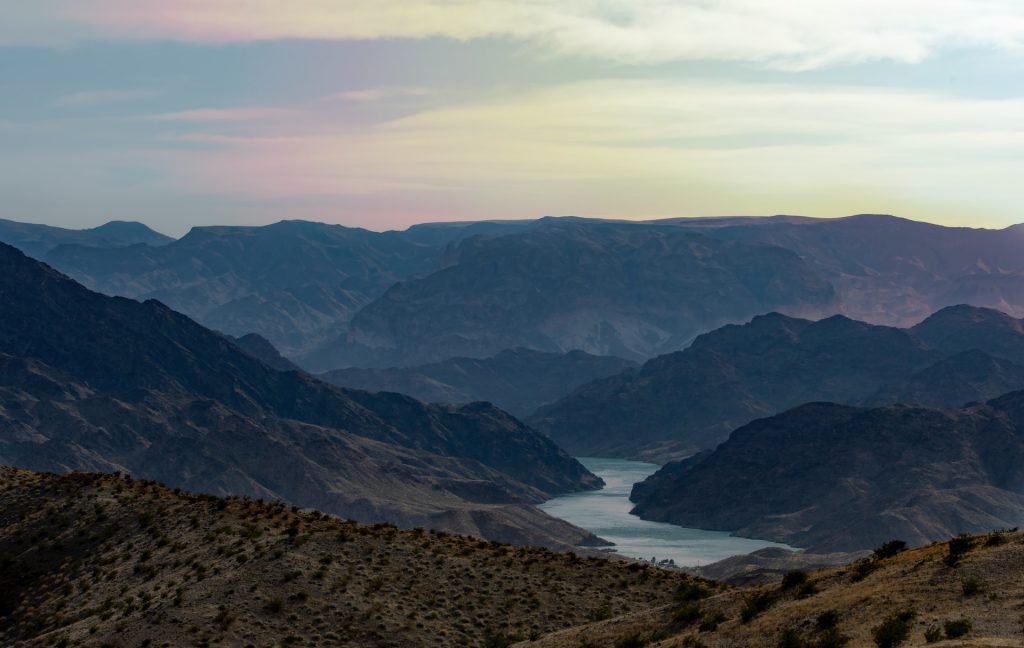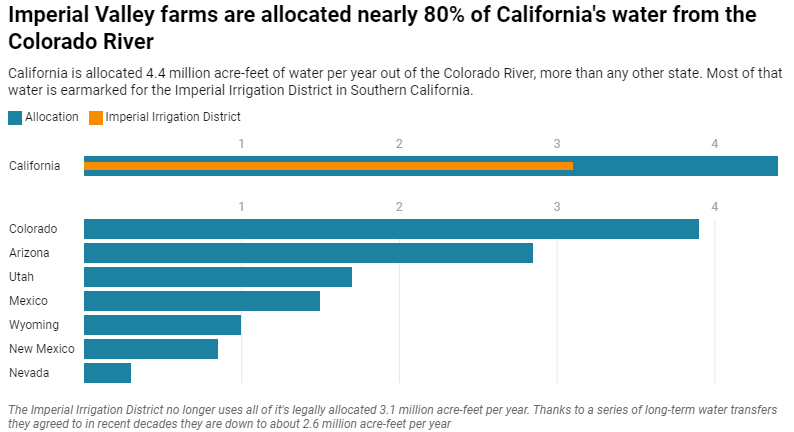Originally published on CalMatters.org, a nonprofit, nonpartisan media venture explaining California policies and politics.
![]()
By
UPDATED
The Biden administration today proposed alternatives for cutting Colorado River water allocations for Southwest states, including one that would substantially reduce the amount of water delivered to Southern California.
One of the three options would retain California’s historic, century-old senior water rights, while another would override them and split the cuts in water deliveries evenly between California, Nevada and Arizona. The even-split option would be a big blow to Imperial Valley farmers while benefiting the other states.
 The river, which supplies water for 40 million people in seven states, has shrunk during the West’s megadrought, with its major reservoirs, Mead and Powell, approaching record lows and expected to eventually run out of water unless user states cut back.
The river, which supplies water for 40 million people in seven states, has shrunk during the West’s megadrought, with its major reservoirs, Mead and Powell, approaching record lows and expected to eventually run out of water unless user states cut back.
The Interior Department’s draft environmental impact statement comes after years of debate over how best to allocate water cuts. It would be the first time that the federal government intervenes to allocate Colorado River water, which has historically been apportioned based on the historic water rights. A final decision by the Interior Department is expected in August, after a public comment period, and will affect the 2024 operation of Glen Canyon and Hoover Dams.
California receives the most Colorado River of all the states, with an annual entitlement of 4.4 million acre-feet. About 2.5 million acre-feet of that goes to the Imperial Irrigation District, one of the nation’s largest agricultural areas and a major producer of alfalfa and lettuce. Much of the rest goes to the Metropolitan Water District, which supplies imported water to cities in Southern California.

The cuts in water deliveries to the three states will amount to about 2 million acre feet next year. (An acre foot is 326,000 gallons.)
In one option presented in the federal report, the reduced Colorado River water deliveries are “based predominantly on the priority of water rights,” according to the Bureau of Reclamation. This option would go easy on the Imperial Irrigation District, which has the most senior water rights, while cities in Arizona and Nevada would be hit hard by the cuts. This first-come, first-served water rights system has become a hot point of contention between water users.
Another option would override the historically bulletproof rights held by the Imperial Valley. In that option, the cuts in allocations “would be distributed in the same percentage” across the three states. It includes “progressively larger additional shortages as Lake Mead’s elevation declines” and “larger Lower Basin shortages in 2025 and 2026 as compared with 2024.” Under that option, California would be hurt the most and have to give up the most water.
The Imperial Irrigation District, which serves farms in the southeast corner of the state, applauded the option that respects its senior water rights and objected to the equal-cut alternative.
“Alternatives that skirt around long-standing water rights, as well as the agreements and laws put in place to address this situation, have the potential to jeopardize existing long-standing California water agency partnerships, and billions of dollars of long-term planning investments that have provided water supply resilience within the state for more than two decades,” the statement declared.
The Metropolitan Water District, which provides imported water to 19 million Southern Californians, voiced opposition to both options.
“Based on our initial assessment…neither of the action alternatives presented today is ideal. Both include significant supply cuts that would hurt Metropolitan and our partners across the Basin. There is a better way to manage the river,” said Adel Hagekhalil, general manager of the Metropolitan Water District.
He added that the federal government’s plan “is a powerful indication of what could come if we don’t reach a consensus. We must keep working to develop a consensus short-term plan, while also collaborating to build long-term solutions that will ensure the river’s lasting sustainability,” such as increasing farm and urban water efficiency.
The third option presented by the federal government is a “no action” plan, staying with the status quo for water use and exports, which is considered an unlikely choice given the emergency conditions.
Last summer, federal officials warned the three states that if they failed to reach an agreement to reduce water use by 2 to 4 million acre-feet each year, the government would impose its own measures. Early this year, six of the states pulled together a plan, with California offering up a separate proposal. The multi-state plan would have meant a cut of more than a million acre-feet per year for California, while its own plan offered to cut back by 400,000 acre-feet per year, with Imperial Irrigation District taking on 250,000 of that.
Federal officials said the draft report follows “months of intensive discussions and collaborative work with the Basin states and water commissioners, the 30 Basin Tribes, water managers, farmers and irrigators, municipalities, and other stakeholders.”
“Failure is not an option,” Deputy Interior Secretary Tommy Beaudreau said in a statement.
“The Colorado River Basin provides water for more than 40 million Americans. It fuels hydropower resources in eight states, supports agriculture and agricultural communities across the West, and is a crucial resource for 30 Tribal Nations,” he said.
Virtually no one disputes that the Colorado River has been greatly overallocated, with users diverting much more water than the river produces. Water supply experts say if significant cuts are not enforced soon, its reservoirs could all but run out of water within just several years.
State-by-state entitlements were codified in the historic Colorado River Compact of 1922. When Mexico was later added to the water allocation scheme, total rights added up to 16.5 million acre-feet a year. While most years consumption is less than that — about 13 million acre-feet — it’s still significantly more than the river’s average output of about 11 million acre-feet, which has declined because of climate change and drought.
JB Hamby, chairman of the Colorado River Board of California, said the wet winter has improved the near-term outlook for states dependent on the river. He said the river could yield more than 14 million acre-feet of water this year.
“So, the worst-case scenario going into this process are a lot less severe in nature than what we were looking down the barrel of just a few months ago,” Hamby said.
Alastair Bland lives in Sonoma County, California. He writes about water, climate, marine research, agriculture and the environment, and his work has appeared at NPR, Time, East Bay Express, Audubon, Hakai,… More by Alastair Bland





